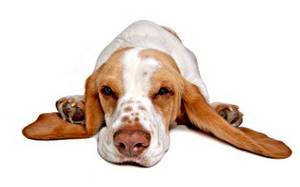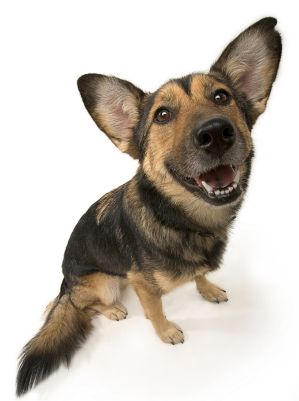How to Clean Your Dog's Ears

Dogs have ears which have evolved to be self-cleaning. The skin grows outwards and carries debris towards the opening of the ear, like a conveyor belt.
The external ear canal is L-shaped with a vertical canal, then a horizontal canal, leading up to the ear drum (the membrane separating the delicate hearing and balance organs from the outside environment).
The ear canal is lined with skin glands (secreting ear wax), and in many cases with hair. Unfortunately, the shape of the ear means that sometimes the self-cleaning mechanism is not as effective as it should be, allowing dirt and ear wax to build up. Ear disease can also upset this mechanism.
If the ears just seem a little grubby, they can be cleaned at home. If the dog shows any signs of infection such as rubbing at the ears, shaking the head, a red and painful ear, a malodorous discharge, tilting the head to one side or hearing loss, a veterinarian should be consulted as antibiotics, anti-fungals or surgery may be required to treat the disease properly.
|
Ear infection treatments
|
| Pet Shed's most popular solutions for treating your pet's ear infections |
There are many good ear cleaners available without a veterinary prescription. The one best for your dog depends on many factors. Most ear cleaners contain a range of ingredients, all with different functions and uses.
Organic acids (salicylic, malic, boric, acetic and benzoic) help remove scaly skin from ears and help to normalize the skin thickness. Some will relieve itching. Some also have weak antibacterial or anti-fungal properties and the combination of acetic acid and boric acid is excellent for treating the most common yeast infection in canine ears. However these can be irritating if used too frequently or on ulcerated ear canals.
Propylene glycol (the same toxic ingredient as in antifreeze) moisturizes, removes ear wax and is a weak anti-fungal agent. It can cause contact dermatitis if used too frequently.
Alcohols help to remove ear wax and dry out the ear, which is good for dogs which swim a lot. However it can dry out some ears too much and lead to irritation. Likewise, menthol and Chlorothymol can be very drying agents.
There are various antibacterial and antifungal substances such as parachlorometaxylenol in Epi-Otic, and other enzymes which break down wax.
 Many cleaners will have both cleaning and deodorizing actions.
Normally, it should not
be necessary to clean an ear more than once or twice a week; in fact it can cause irritation if done too frequently.
If you use cleaners in a diseased ear in conjunction with medicated ear drops, follow your veterinarian's
instructions
on cleaning frequency. In general, cleaners should be applied an hour or so before the medicated drops, so the dog
has
time to shake out the excess to prevent it diluting or interfering with the medication.
Many cleaners will have both cleaning and deodorizing actions.
Normally, it should not
be necessary to clean an ear more than once or twice a week; in fact it can cause irritation if done too frequently.
If you use cleaners in a diseased ear in conjunction with medicated ear drops, follow your veterinarian's
instructions
on cleaning frequency. In general, cleaners should be applied an hour or so before the medicated drops, so the dog
has
time to shake out the excess to prevent it diluting or interfering with the medication.
Most ear cleaners can be toxic to the middle or inner ear, causing deafness or balance problems. A ruptured ear drum leaves these parts of the ear exposed and vulnerable, so do not use an ear cleaner if you suspect this is the case, or advised to do so by your vet.
Actually cleaning a dog's ears can be a messy task and is best done outdoors. Don't wear your best clothes when doing so as you may end up covered in ear cleaner! Here is a simple step-by-step guide:
First apply the cleaner liberally into the opening of the ear canal, until you can see the liquid just starting to overflow, which means the whole ear canal is coated with the solution. You may also want to apply some to the underside of the ear flap (or "pinna").
Then gently massage the product in the ear canal. Underneath the opening of the ear, you will feel a firm tube of cartilage and squeezing and rubbing this gently will help distribute the ear cleaner and break up ear wax and any other discharges. You should hear a squelching noise when doing this if you have applied sufficient cleaner.
|
"Actually cleaning a dog's ears can be a messy task and is best done outdoors. Don't wear your best clothes
when doing so as you may end up covered in ear cleaner!"
|
Keep up the massage for up to 30 seconds then stand back and let the dog shake out some of the excess cleaner, dirt and wax . Most dogs enjoy this and will tilt their head towards you during the massage.
Use some cotton wool balls to wipe away some of the visible dirt from the opening of the canal, in the folds of the ear and on the ear flap. You can use cotton tip applicators (Q- tips) to get into the skin folds but do not put this into the ear canal. You should always be able to see the tip to ensure it is not too deep in the canal. You don't want to push the wax further down into the canal or even damage the ear drum if you push too far.
Repeat the process until the fluid coming out no longer appears to be dirty. Always reward your dog with a pat or a treat when he or she cooperates and allows you to clean the ear as this will reinforce it as being a positive experience.
Epi-Otic is a registered trademark of Virbac.